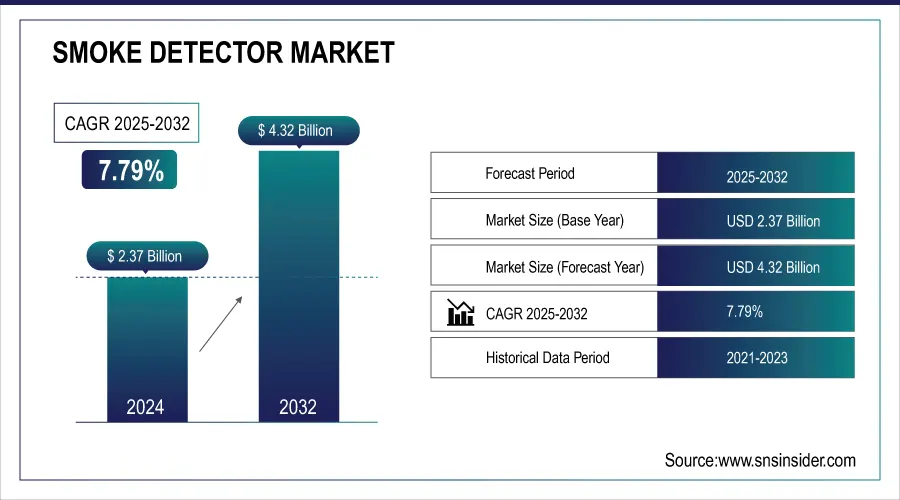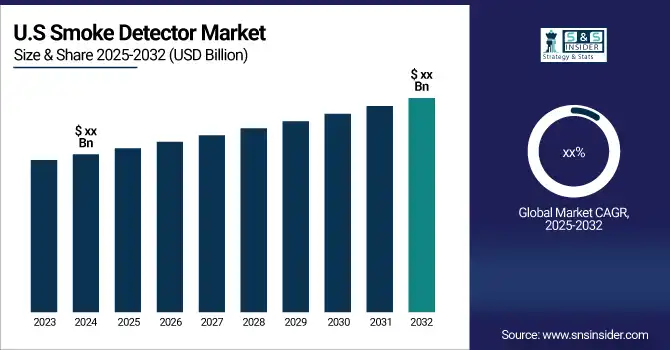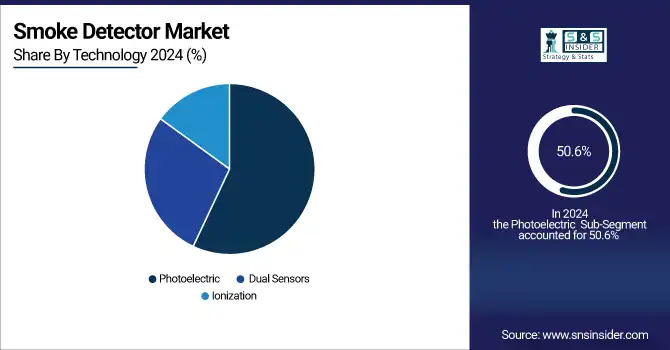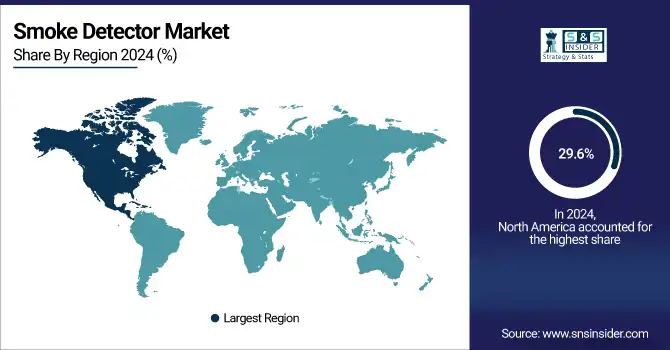Smoke Detector Market Size & Trends:
The Smoke Detector Market Size was valued at USD 2.37 billion in 2024 and is expected to reach USD 4.32 billion by 2032, growing at a CAGR of 7.79% over the forecast period 2025-2032. The increase in product technology is a major factor fuelling the growth of the Smoke Detector Market. New technologies such as AI-enabled sensors, multi-parameter monitoring, and wireless communication enhance the safety level and reduce false alarms. It has also improved performance reliability, including self-testing features, longer battery life, and rapid response times. Emergence of smart and connected smoke detectors integrated with Wi-Fi, Bluetooth, and IoT applications providing features such as remote monitoring, mobile alerts, and voice assistant compatibility These developments support fire detection across home, business, and factory-level applications, rendering fire detection many times more efficient, automated, and sensitive to real-time hazards.

To Get more information on Smoke Detector Market - Request Free Sample Report
Market Size and Forecast:
-
Market Size in 2024: USD 2.37 Billion
-
Market Size by 2032: USD 4.32 Billion
-
CAGR: 7.79% from 2025 to 2032
-
Base Year: 2024
-
Forecast Period: 2025–2032
-
Historical Data: 2021–2023

Key Smoke Detector Market Trends
-
Growing adoption of smart smoke detectors integrated with IoT and wireless connectivity for real-time monitoring.
-
Rising demand in residential and commercial buildings due to stringent fire safety regulations.
-
Increasing use of photoelectric smoke detectors owing to higher accuracy in detecting smoldering fires.
-
Integration with smart home ecosystems (Alexa, Google Home, Apple HomeKit) enhancing consumer convenience.
-
Advancements in battery technology with long-life lithium batteries reducing maintenance needs.
-
Expansion of wireless and interconnected smoke alarms improving coverage and early warning systems.
-
Surge in demand from emerging economies driven by rapid urbanization and infrastructure development.
Smoke Detector Market Growth Drivers
-
Rising Fire Safety Regulations and Smart Technology Drive Smoke Detector Market Growth
The growth of the smoke detector market is driven by the increasing fire safety regulations and growing awareness of fire safety in residential, commercial, and industrial properties. Mandatory fire safety regulations by governments across the globe have surged the adoption rates in the smoke detectors market. Furthermore, the increasing adoption of smart homes and technological innovations in sensor technology, including IoT-based detectors available with remote monitoring and real-time notifications are further fuelling the market growth. Demand is further boosted by the boom in construction, as new buildings must adhere to strict fire safety regulations, particularly in several emerging economies. In addition, Rising incidences of fire accidents and losses are improving investments by consumers and organizations in fire detection solutions.
Smoke Detector Market Restraints
-
High Costs Maintenance Challenges and False Alarms Restrain Smoke Detector Market Growth
The high growth potential of the market is again hampered by some restraints such as the high upfront installation cost and deployment cost associated with efficient maintenance of the smoke detectors. Most of the advanced smoke detectors which are mainly integrated with IoT and smart homes are expensive and the adoption rates are low in sensitive geographical places, with high sensible cost. Moreover, upkeep difficulties such as replacing the batteries regularly and adjusting the sensors can create a disincentive for consumers to buy these devices. Moreover, false alarms owing to environmental parameters such as dust, humidity, and cooking fumes represent a major issue that causes user distress and sometimes even causes them to deactivate their devices causing reduced overall market demand.
Smoke Detector Market Opportunities
-
Technological Advancements and Emerging Markets Drive Growth Opportunities in Smoke Detector Market
The Smoke Detector Market has the potential opportunity to further grow in areas of technical innovations and areas that are emerging in terms of geography. Artificial intelligence and machine learning make smoke bosques more precise compared to traditional smoke detectors, mitigating false alarms and allowing manufacturers to maintain a competitive advantage. Furthermore, the wireless and battery-operated detectors are a valuable contributor to this segment as the requirement for retrofitting older buildings is also observed. It is emerging markets in Asia-Pacific and Latin America where this developing urbanization and infrastructure carries the biggest scope for growth. In addition, growing consumer awareness of integrated and smart safety solutions provides avenues for vendors to add value to the opportunity and its share.
Smoke Detector Market Challenges
-
Regulatory Variations Low Awareness and Counterfeit Products Challenge Smoke Detector Market Growth
The challenges of the market include different regulatory compliance in different regions and low awareness in underdeveloped areas. Because of excellent variances in fire safety standards from country to country, and region to region, this is a drive for manufacturers not to supply uniform goods globally. Consequently, the price of generation and regulatory challenges are high. Additionally, in the case of other developing and rural areas, the limited awareness regarding fire safety measures and less enforcement of fire safety regulations inhibit market growth. The proliferation of low-quality and counterfeit products in the market contributes to reliability issues leading to a corresponding lack of consumer confidence in smoke detection. Fortunately, these challenges can eventually be solved with continuous innovation, government support, and awareness campaigns on fire safety advantages to further educate users.
Smoke Detector Market Segment Analysis
By Technology
Photoelectric smoke detectors led the market in 2024 with a 50.6% share as they are very effective in detecting slow-burning, smoldering fires. These are commonly used for residential and commercial buildings due to their high reliability and lower false alarms.
Dual-sensor smoke detector segment is projected to be the fastest-growing segment from 2025 to 2032 This growth is attributable to the increasing requirement for advanced fire safety solutions with ionization and photoelectric technologies coupled for added better accuracy. The growth of dual-sensor detectors is further complemented by increasing fire safety regulations as well as the proliferation of smart technologies.

By End Use
In 2024, industrial accounted for the dominant smoke detector market share of 42.8%, owing to the high implementation of strict provisions for fire safety and the rising requirement for advanced fire detection systems across factories, warehouses, and manufacturing plants. Increasing demand for reliable smoke detection solutions is further driven by high-risk environments, particularly in the oil & gas, chemicals, and mining industries.
The residential segment is projected to be the fastest-growing segment from 2025 to 2032. The growth of the residential market over the forecast period is driven by growing awareness about home fire safety, the growing adoption of smart homes, and mandatory initiatives taken by the government related to smoke detectors being installed in homes.
Smoke Detector Market Regional Analysis
North America Smoke Detector Market Insights
In 2024, North America accounted for a leading market share of 29.6% in the smoke detector market, owing to the stringent fire safety regulations in the region, increasing adoption of smart home technologies, and rising awareness regarding fire hazards. Smoke detectors are required in residential, commercial, and industrial buildings, in both the U.S. and Canada where stricter building codes and fire safety standards have been introduced. Moreover, well-known market players such as Honeywell International, Kidde (a subsidiary of Carrier), and First Alert have helped North America hold strong positions in the market. For example, California has some of the most stringent fire safety regulations in the world, mandating smoke alarms with a 10-year sealed battery in every home, which has propelled the adoption of the product.

Get Customized Report as per Your Business Requirement - Enquiry Now
Europe Smoke Detector Market Insights
The European region is anticipated to have the fastest growth from 2024 to 2032, owing to the growing awareness of fire safety, the rise in demand for smart homes, and government laws favoring this development. The demand for an efficient smoke detection system is further driven by the strengthening of fire safety policies in countries including Germany, France, and the UK. As an example, Germany has a nationwide law requiring smoke detectors in every residential building which in turn leads to more market penetration. Turnkey manufacturers and players having a face in the European region, are reportedly innovating with AI-integrated, IoT-enabled smoke detectors that are predicted to further accelerate market growth.
Asia Pacific Smoke Detector Market Insights
Asia Pacific is projected to account for 27.8% of the global Smoke Detector market in 2024, driven by rapid urbanization, rising construction activities, and increasing enforcement of fire safety regulations. Countries such as China, Japan, and India are at the forefront, with strong demand from residential, commercial, and industrial sectors. The growing adoption of smart building technologies and IoT-enabled safety systems is further accelerating market expansion. Additionally, government-led initiatives for infrastructure safety, coupled with rising consumer awareness about fire prevention, are strengthening the Asia Pacific’s role as one of the fastest-growing regions in the global Smoke Detector market.
United States Smoke Detector Market Insights
The United States dominates the Smoke Detector market with a 42.3% share in 2024, supported by stringent fire safety regulations, widespread adoption of smart home technologies, and strong demand across residential, commercial, and industrial sectors. States such as California, Texas, and New York are key markets, driven by rapid urban development and advanced building codes. Growing integration of AI-enabled detectors, wireless connectivity, and compliance with UL268 7th Edition standards are further reinforcing the U.S. as a global leader in Smoke Detector innovation and adoption.
Latin America (LATAM) Smoke Detector Market Insights
Latin America holds 11.4% of the Smoke Detector market in 2024, fueled by expanding construction activity, modernization of residential and commercial infrastructure, and growing awareness of fire safety standards. Brazil and Mexico are the dominant markets, supported by government initiatives for building safety and rising adoption of smart fire detection systems. Increasing foreign investments in real estate and infrastructure projects are accelerating demand, positioning LATAM as an emerging yet steadily expanding Smoke Detector market.
Middle East & Africa (MEA) Smoke Detector Market Insights
The Middle East & Africa region is projected to capture 18.5% of the global Smoke Detector market in 2024, driven by large-scale urbanization, smart city initiatives, and stricter safety regulations in new infrastructure projects. Countries such as Saudi Arabia, the UAE, and South Africa are leading adoption, integrating advanced smoke detection systems in residential, commercial, and industrial buildings. Strategic collaborations with global safety technology providers and regional investment in energy-efficient and IoT-enabled systems are strengthening MEA’s position as a high-growth market for Smoke Detectors.
Smoke Detector Market Competitive Landscape
Hochiki Europe
Hochiki Europe is a U.K.-based leading fire detection and life safety solutions provider, offering a wide portfolio of smoke detectors, emergency lighting, and fire alarm systems.
-
In March 2025, Hochiki Europe introduced advanced smoke detectors for conventional applications, ensuring compliance with UL268 7th Edition standards. The new models are designed to enhance fire detection accuracy while significantly reducing false alarms, strengthening the company’s position in the European fire safety market.
Smoke Detector Market Key Players
Some of the major players in the Smoke Detector Market are:
-
Gentex Corporation (Photoelectric Smoke Detector)
-
Honeywell Gent (S-Quad Sensor)
-
Simplex Fire Alarm System (TrueAlarm Smoke Detector)
-
Notifier Fire Alarm System (FSP-851 Smoke Detector)
-
Eaton Fire Alarm (Optical Smoke Detector)
-
System Sensor Company (i3 Series Smoke Detector)
-
Zeta Alarms Ltd (Zeta Smoke Detector)
-
Hochiki Fire Alarm (ALG-V Photoelectric Smoke Sensor)
-
Janus Fire Systems (JFS-SD300 Smoke Detector)
-
Fire Lite Alarms (SD355 Addressable Smoke Detector)
-
Panasonic Fire & Security Europe AB (Panasonic Smoke Detector)
-
PineTree Fire Alarm (Wireless Smoke Detector)
-
ELFRI srl (ELFRI Smoke Detector)
-
Adeva Fire Alarm System (Adeva Smoke Detector)
-
EDS Elektronik (EDS Smoke Detector)
| Report Attributes | Details |
|---|---|
| Market Size in 2024 | USD 2.37 Billion |
| Market Size by 2032 | USD 4.32 Billion |
| CAGR | CAGR of 7.79% From 2024 to 2032 |
| Base Year | 2024 |
| Forecast Period | 2025-2032 |
| Historical Data | 2021-2023 |
| Report Scope & Coverage | Market Size, Segments Analysis, Competitive Landscape, Regional Analysis, DROC & SWOT Analysis, Forecast Outlook |
| Key Segments | • By Technology (Photoelectric, Dual Sensors, Ionization) • By End Use (Commercial, Industrial, Residential) |
| Regional Analysis/Coverage | North America (US, Canada), Europe (Germany, France, UK, Italy, Spain, Poland, Russsia, Rest of Europe), Asia Pacific (China, India, Japan, South Korea, Australia,ASEAN Countries, Rest of Asia Pacific), Middle East & Africa (UAE, Saudi Arabia, Qatar, Egypt, South Africa, Rest of Middle East & Africa), Latin America (Brazil, Argentina, Mexico, Colombia Rest of Latin America) |
| Company Profiles | Gentex Corporation, Honeywell Gent, Simplex Fire Alarm System, Notifier Fire Alarm System, Eaton Fire Alarm, System Sensor Company, Zeta Alarms Ltd, Hochiki Fire Alarm, Janus Fire Systems, Fire Lite Alarms, Panasonic Fire & Security Europe AB, PineTree Fire Alarm, ELFRI srl, Adeva Fire Alarm System, EDS Elektronik. |

